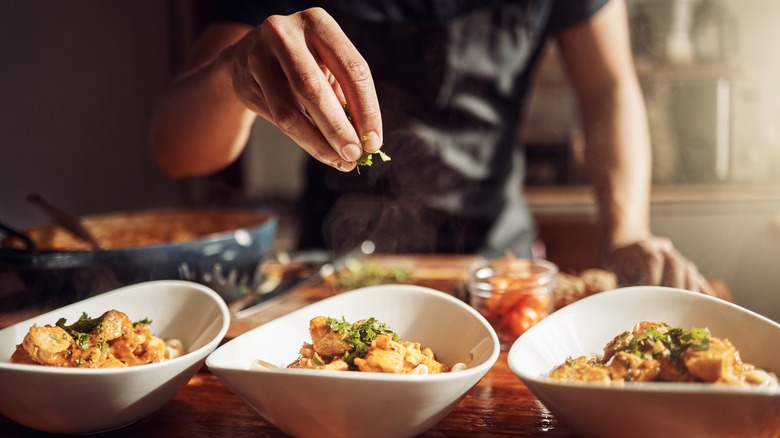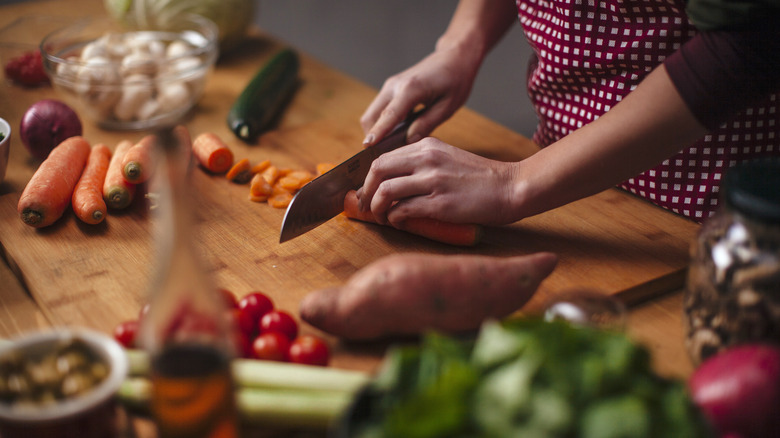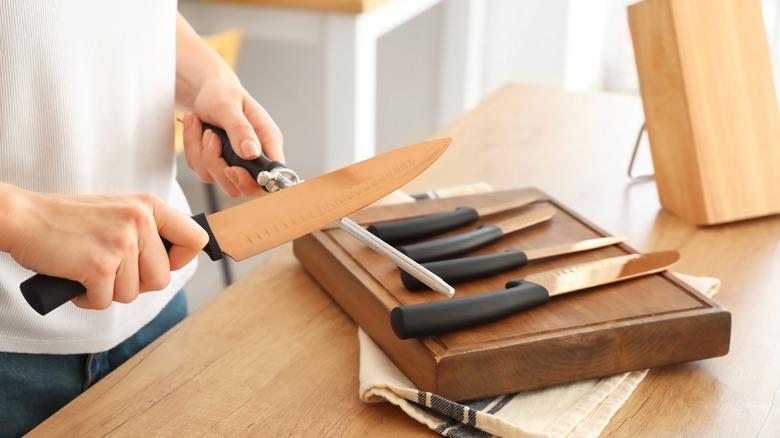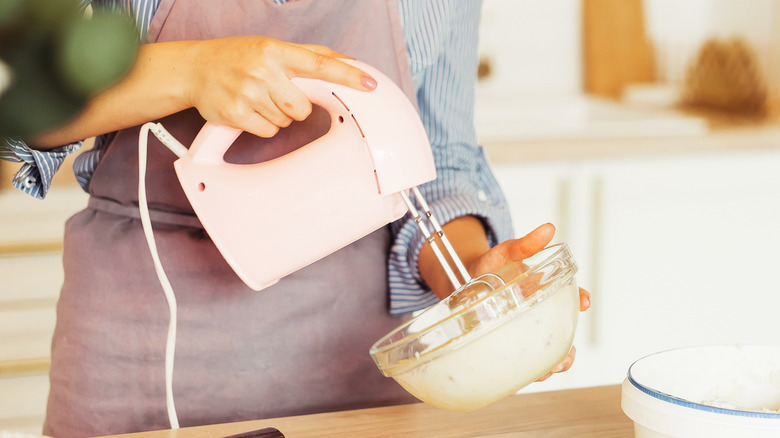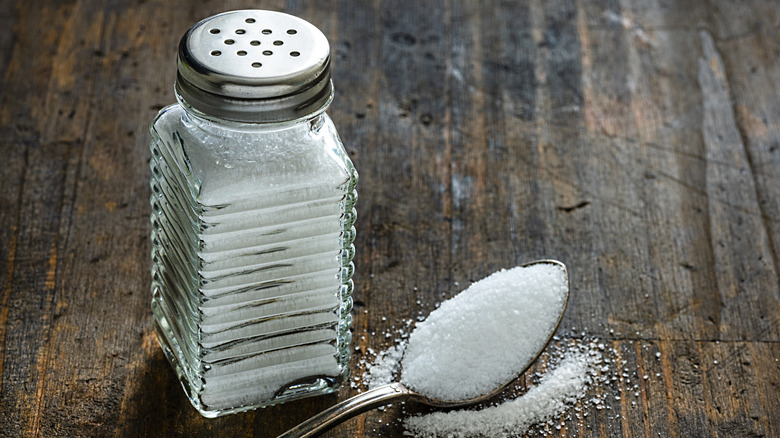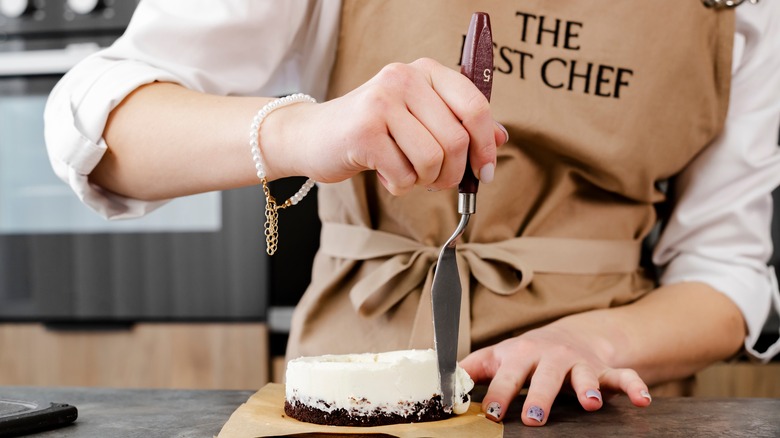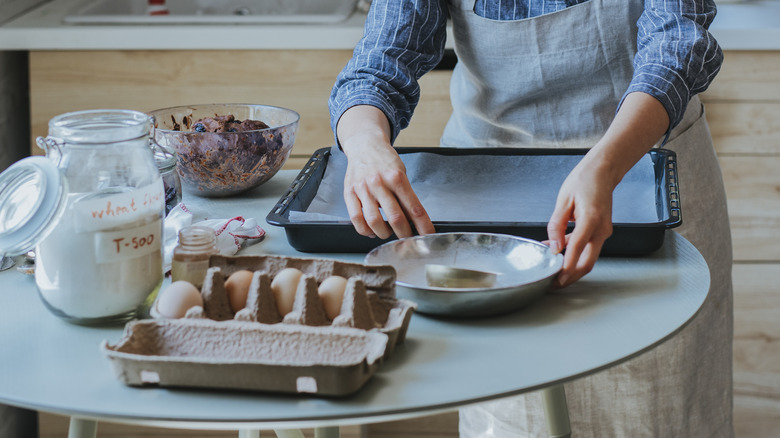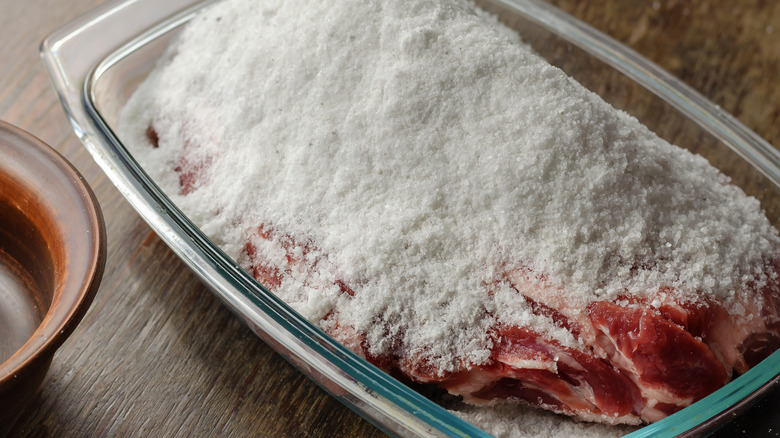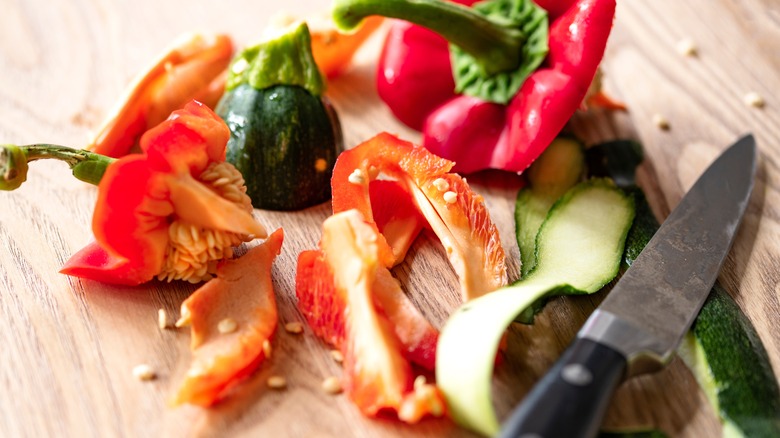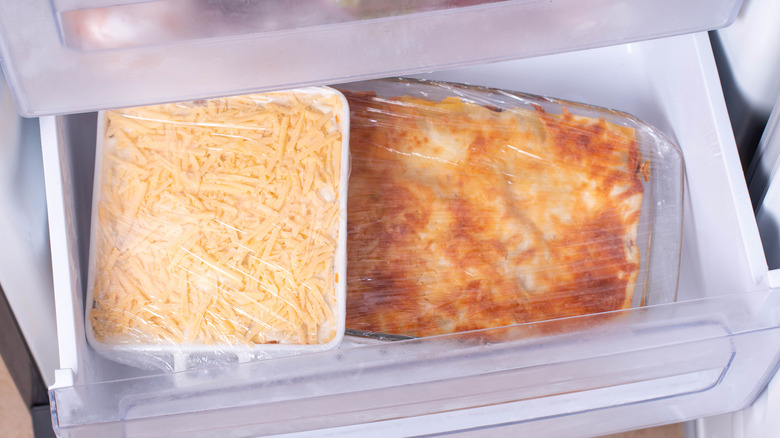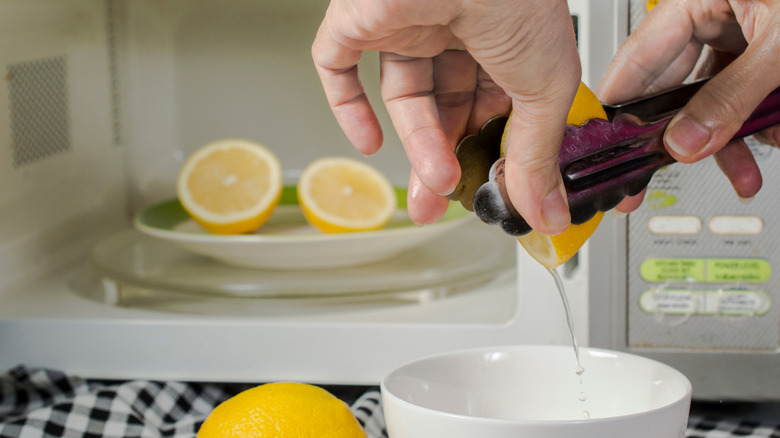12 Restaurant Meal Prep Hacks You Can Use At Home
There are plenty of tips and tricks out there that you can use to make preparing meals at home more efficient. The restaurant world, in particular, has countless ways to make delicious and healthy foods without the often-arduous cooking prep. The truth is that most dining establishments have mastered the skill of creating a remarkable meal in 30 minutes or less with little to no fuss.
With some of the industry's best-kept secrets at your disposal, you'll quickly come to see that there's really no reason to spend hours in the kitchen. Likewise, you'll no longer have to worry about your culinary creation being lackluster if you happen to be missing a key ingredient or don't have certain recipe-required cooking aids on hand. Proper preparation and just a few innovative additions to your kitchen are all you need to whip up a smörgåsbord of great eats. So, to help you along this journey, here are 12 restaurant meal prep hacks you can use at home.
Prepping the right veggies in advance
When making dishes that require lots of fresh-cut produce, a useful restaurant hack you can use is to prep this produce in advance. Everything from leafy greens, peppers, and cucumbers to strawberries and various citrus fruits can all be prepped — i.e., washed, dried, and sliced up — a few days beforehand. That said, not all produce can be readied ahead of time. Popular meal accompaniments like potatoes, sliced tomatoes, avocados, and onions rarely hold up well when prepped too early, at least without additional tricks.
For instance, in eateries that use avocados, the earliest these fruits can be prepped for service is around four hours. The cut-up avocados are then stored in a cold-water bath to lessen the effects of oxidation. Doing this with your avocados at home, however, is time-consuming and likely unnecessary since you aren't feeding a large rush of people. Typically, only heartier produce like carrots, broccoli, cauliflower, Brussels sprouts, and cabbage can be cut up and stored for several days. Mushrooms, squash, peppers, and similar produce can be prepared around two days prior to use. And remember, when readying the right fruit and veggies in advance, try using a mandolin for quick, easy dicing and slicing.
Properly prepping your cooking essentials
Cooking often involves a handful of utensils, gadgets, and kitchen essentials. Even if you have all the right items in your kitchen for any given recipe, you'll benefit from having your essentials prepped just as thoroughly. Restaurants often keep their appliances and culinary go-to's in tip-top shape, making cooking much easier — so it's imperative that you do the same at home.
Simple hacks like chilling your cling wrap, for example, allow for trouble-free usage since the added coldness temporarily makes the wrap less sticky. Using lemons and some salt to clean your cutting board is yet another hack that ensures your prime cooking space will stay disinfected and stain-free — without all the harsh cleaning products. Likewise, pros often fine-tune their high-quality knives with a honing rod to give them a realigned edge. Of course, you'll still want to sharpen the blade, either with a whetstone or with some other knife-sharpening means. Using a honing rod, however, can help maintain your knife's razor-sharp edge for longer than usual. Other restaurant tricks, like keeping a garbage bowl on hand, recycling used cooking oils, and filling your sink with soapy water (in order to wash and rinse your dishes as you cook), are just a few more ways to prep.
Using the best cooking techniques
Besides following the unspoken restaurant rule of keeping "everything in its place" so your kitchen is always prepped and ready for use, staying up-to-date on the latest and best cooking techniques is a must. For the most part, gone are the days of gatekeeping — chances are there's a tutorial, a step-by-step how-to, or some other guide awaiting your discovery. Easy hacks like cooking bacon in the oven to avoid a messy stove top or using a smear of mayo to create the crispiest crust on your pan-fried meats are quick and easy game changers.
But that's not all — from using a water-and-butter mixture to achieve the perfect vegetable glaze to infusing dishes with the right kind of wine or spirits (not just the nearest one in your fridge), there are dozens of techniques that can take your home cooking to the next level. Similarly, opting for fresh herbs instead of the readily available jar of dried seasonings may seem tedious at first, but you can easily grow your own herbs at home, saving you both time and money. Dried herbs truly pale in comparison, especially if the goal is to breathe life into dull flavors with the freshest ingredients. Additionally, polishing up on your searing, sautéing, oven-roasting, blanching, and basic knife skills doesn't hurt, either.
Making the most of kitchen appliances and gadgets
If you're looking for the best way to cook something, more often than not, this also includes making the most of your kitchen appliances and gadgets. Investing in quality mixers, air fryers, knives, cutting boards, cookware, and then some can upgrade your finished meals. That said, you have to do your research to ensure that you're buying first-rate equipment (and actually using it) — many home chefs simply purchase what's popular or aesthetically pleasing without considering whether or not it's practical.
Alternatively, home chefs may not even properly utilize their gadgets to make the cooking process easier. Here's a prime example: When a recipe calls for shredded chicken, it can be tempting to just reach for a couple of forks and do it by hand. If you're meal-prepping like the pros, however, then you'll know to grab your hand-held mixer or electric beater instead. You can use an electric beater to shred chicken in no time at all and with less effort, allowing you to move on to your recipe's next step with ease. A hand-held beater also makes peeling and mashing potatoes a breeze, so get ready to spin some spuds the restaurant way.
Using the right salt
Kosher, coarse, and table salts are not the same. In fact, there are roughly 12 different salts that you can use for cooking. If you've just been grabbing whatever salt you have on hand, even the multi-purpose or iodized one, it's time to think again. Opting for a salt that complements rather than detracts from your dish's overall flavors is just one more restaurant hack that can make a world of difference.
Simple table salt, for instance, works best in sauces, dressings, and for giving your dish a little extra bite. Table salt can also be used in baking. In contrast, coarse salt, typically from a grinder, is great for red meats. Similarly, Kosher salt is ideal for seasoning other hearty meats and vegetables. Another popular salt in people's kitchen pantries, the Himalayan variety, can be used in everyday cooking and as a finishing touch when needed. Other less common options like Red, Black, Smoked Gray Sea Salt, and Maldon each add their own flavor, ranging from savory to sweet to smoky. These same salts are great additions to vegan cuisine, fish, marinades, soups, and more.
Investing in an offset spatula
An offset spatula is practically an extension of a restaurant chef's right hand thanks to its variety of practical uses. More than just an alternative option for frosting baked goods, the offset spatula is a slender, multi-purpose kitchen tool. On average, this flexible and lightweight spatula is about the size of a butter knife, though it's available in several other sizes. Nonetheless, an offset spatula has a more rounded, angled tip compared to a standard cutlery knife. Restaurant chefs used this handy baking tool for just about everything — icing cakes, flipping meats, removing baked goods from their pans, spreading sauces, making crêpes, and so on.
Investing in an offset spatula allows you to get things done without making a mess or experiencing mishaps. Due to its flexibility, stability, and precision ability, this kitchen tool is the perfect utensil for countless kitchen moves — smoothing out ganaches, spreading peanut butter, glazing entrees, taste-testing, and separating pan-fried proteins from their skillet. Despite there being a kitchen "essential" out there for just about everything, using an offset spatula can save you valuable time by streamlining the entire cooking or baking process. (Plus, you will have far fewer dishes to wash afterward.)
Keeping parchment paper in your kitchen
The unsung hero of any kitchen might just be parchment paper, otherwise known as baking paper. This heat-resistant gem is used in quite a few restaurant cooking hacks. You can use this paper for standard tasks like lining your air fryer, preventing poaching liquids from drying up, and evenly baking your cookies. Perfect for making a cartouche (a lid that slows down your food's evaporation rate), this cellulose-based paper is crucial for incredible stews, flawlessly steamed veggies, marvelous gravies, and then some.
What's more, baking paper helps alleviate sticky messes left behind after cooking; just line your bakeware to avoid burnt sheet pans. Home chefs looking to steam meats and keep food that's fresh out of the oven nice and crisp should also pull out the parchment paper. Even during meal prep itself, you can lay out some paper on your counter beforehand for easy clean-up. With countless usages in the kitchen, you never know when this tried-and-true paper will save the day. So, do yourself a favor and keep this cellulose-based paper well-stocked.
Curing meats overnight
Though curing meat seems simple enough, it's actually a bit of an art. Before delving into this longstanding technique, however, let's explain why people cure meat to begin with. Once the only available method for preserving food, curing meat (often with salt) prevents the spread of bacteria, making it safe to consume at a later date. In today's kitchen, however, curing meat overnight is more of a way to bring out its flavors.
With multiple methods — dry curing (smoking or hanging), wet curing (brining), and more — you can experiment with this method's countless techniques if you so choose. Most other forms of curing, however, aren't usually for next-day cooking. With that in mind, dry curing is known to make meat much more flavorful, while wet curing tends to make meat juicier, more tender, and extra seasoned. Depending on your goal here, you can even improve upon the taste and texture of your meal by curing meats overnight. Whether you plan on grilling, pan-frying, or roasting your cured cuts is up to you, but be ready for some of the best meat you have ever had when all is said and done.
Getting creative with your leftovers
Getting creative with your leftovers and meal prep scraps is a restaurant hack that ensures nothing is wasted unnecessarily. (All you need for motivation is one trip to the grocery store to see how expensive everything is.) Now more than ever, you should be repurposing where you can. For already-cooked meals, one of the easiest ways to make the most out of your dinner is to pack it up for lunch the following day.
Turning leftovers into ingredients for another dish is another popular option. Try taking last night's chicken dinner and making sandwiches or using your veggie side from yesterday in tonight's soup. On the other hand, lets say you made more lasagna than you can eat in one sitting; instead of letting the remaining chow go to waste, why not freeze some for later (in this case, for up to three months)? Bread can also be repurposed for a variety of wonderful eats, like French toast, bread puddings, stuffing, salad croutons, and casseroles. If you have leftover vegetable scraps, there's no need to chuck them in the garbage bowl. Instead, try using these scraps for stock or even taking the seeds and starting your very own vegetable garden.
Saving time with freezer-friendly meals
It may surprise you to know that many restaurants offer frozen foods on their menu. Whether this is because they offer their patrons a wealth of options or because it would take too long to make certain elements of a dish from scratch in real time, restaurant chefs sometimes rely on foods the they pre-made and froze. Similarly, for those cooking at home, there's seldom enough time in the day to make something from scratch, so why not help you help yourself?
Try whipping something up and simply freezing it for later, like extra lasagna. Along these same lines, if you want a common hack for keeping nutrient-rich veggies and fruits available, just buy the frozen ones. In both the restaurant and in your home kitchen, freezer-friendly, pre-made meals and sides help keep the grocery bill down and can help you maintain food safety. Frozen veggies, in particular, are a great option that allows you to either incorporate more vegetables into your meals or simply focus on the main entrée rather than spending ample time making a side.
Using shortcuts
From organizing your kitchen in the most efficient manner to spending less time trying to juice a lemon, there are quite a few quick-fix solutions out there that just make cooking less difficult. Painless restaurant tricks like storing your knives in a clutter-free area to protect them from possible damage (and to protect you from injury) just make sense. Investing in a kitchen utility cart or trolly is another tip that restaurant chefs swear by. Not only do these give you more storage space, but more meal prep space, as well. Plus, your home kitchen trolly can double as a service cart if you happen to have a lot of good eats that you want to bring over to the table all at once.
Cooking shortcuts like popping hard-to-juice fruit — such as lemons and limes — in the microwave for a few seconds so they yield more juice or making large batches of commonly used sauces (gravies, marinara, salad dresses, marinades, etc.) are great ways to keep up your momentum in the kitchen. Even if you're missing a gadget, there's likely a chef-approved solution out there. For instance, if you need a funnel but don't seem to have one, just grab some plastic wrap, pour your desired food in the middle, roll up the plastic sheet, snip off one end, and squeeze the other into your desired container. This is an easy way to get liquids into a small container or a squeeze bottle.
Labeling all your prep work and leftovers
Finally, when the prep and cooking are over, you have to put things away and clean up. Having a spotless, ready-to-go meal prep station for the next time you're in the kitchen will undoubtedly make the process less stressful. To prevent all your hard work from going to waste, remember to label all your prep, including your leftovers. To make sure you can keep track of each item, try adding the name, quantity, and date. You can even jot down some key cooking or reheating details if you like. This way, you aren't left guessing what something is, if it's still good, or if you have enough of said ingredient. Additionally, if you short-formed a recipe on your container, then you'll know exactly what you planned on doing with your stored food, too.
While you're busy labeling your prep and leftovers, you should also invest in deli containers rather than traditional Tupperware or other food storage. Deli containers come in multiple sizes, take up less fridge space, have interchangeable lids, and are easy to write on — so keep this restaurant hack in mind. Ultimately, cooking at home with any of these pro tricks will only improve your kitchen and home dining experience for the better.
